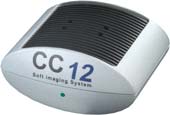CC-12
CC-12 는 어떠한 광학 현미경 어플리케이션에도 대응하는 고해상도 12비트 칼라 CCD 카메라 입니다.
FireWire 기술 (IEEE1394)에 의한 Peltier 냉각 및 전력을 공급받으며 어떠한 저조도 환경에서도 최적의 신호대 잡음비를 제공해 줍니다.
CC-12는 “analySIS Five” Image Analyzer Software에 완전히 통합됩니다.
Digital solutions – Developed to be exceptional
The series of light microscope cameras by Soft Imaging System has been designed to meet the highest digital-imaging acquisition demands for all areas of the microscopy field.
The CC-12 is the successor to the ColorView 12. This 12-bit, Peltier-cooled and FireWire™(IEEE 1394) equipped color digital camera is the ideal introduction to digital image acquisition in the field of light microscopy.
All functions of the camera can be completely controlled and operated via the analySIS®image-analytical software. No matter what current acquisition conditions are, real-time functions guarantee that the entire dynamic range is taken advantage of. This ensures the user optimal contrast all the time.
Following acquisition, CC-12’s total integration into analySIS® provides the full range of options and advantages of the latest in image processing and analysis, from image labeling to archiving, report generation and e-mailing all the way on to photo-realistic printouts – and there’s no more need for the darkroom.
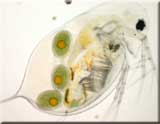
daphnia longispina (long-spined water flea) with eggs
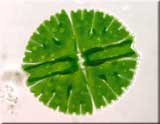
micrasterias rotata (a desmid – single-celled green algae)
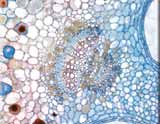
stem axis of tulipa gesneriana (garden tulip)
High Resolution
The CC-12 camera has a resolution of 1300 x 1030 pixels. This is three times greater than that of a regular video camera.
A camera that’s low-noise and cooled
Highly efficient readout technology (Correlated Double Sampling) coupled with Peltier-cooling of the CCD chip results in images of superior signal-to-noise ratio.
Highly sensitive CCD elements are even capable of detecting signals that are extremely weak. The electronic shutter offers variable exposure times ranging from 100 µs to 160 seconds.
The high speed ADC (Analog-Digital Converter) working at a clock rate of 20 MHz in full 12-bit dynamic range is able to perform double sampling even at a readout rate of 20 MHz. Various frame rates are supported by this camera. For example, the camera can be set to acquire at a high frame rate of more than 22 fps at TV resolution using 2x binning. View your zoomed-in sample, locate the area of interest and focus – all conveniently onscreen. No longer are you forced to trade off speed for quality. For acquisition the system switches automatically into the high-resolution mode. This avoids bleaching of your fluorescence specimen and offers optimal performance when setting parameters.
FireWire™ technology guarantees that the CC-12 installation is easy on any PC or laptop equipped with a FireWire™ port. The days when you were limited to a frame grabber and just a single camera are history. FireWire™ technology enables you to use multiple cameras on the same PC.
Image noise is generally the result of one of two things: either the CCD chip is not being cooled to a low enough temperature (known as ”dark current”), or due to mechanical vibrations. For the CC-12, thermal noise and instability is not a problem because the CCD chip is Peltier-cooled and stabilized at 10°C, resulting in a very high signal-to-noise ratio. Noise is further suppressed by the application of a highly efficient digital readout technique known as Correlated Double Sampling.
The CC-12 can be mounted onto all light microscopes with a C-mount adaptor. Plus, you only need one cable for getting data and power to the PC’s FireWire™ port. No more clutter and no ’octopus’ of cables getting in your way.
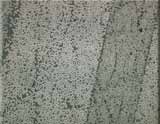
carbon fiber
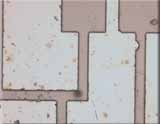
chip structure
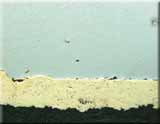
protective lacquer coating
CC-12 is fast. Put this in combination with the high speed of today’s CPU’s, and you’ve got an attractively broad range of real-time functions within analySIS® available to you. These include automatic contrast control, automatic white balance and histogram display.
A vast library of text, graphic and editing functions is available for labeling images. Special filters and professional particle analysis assist in more extensive investigation of images. All this makes it simple to obtain reliable and reproducible results quickly.
Photo-quality printouts can be obtained following acquisition without any need for a darkroom nor its developing chemicals. And these photo-quality printouts are in your hands in minutes.
Archiving
analySIS® offers you a powerful, fully network-able, image-archiving system that handles all the images and data generated during the process of image acquisition and documentation. Images can be stored along with text, sheets and other graphics as records for complete documentation of tasks and processing steps. Input, display and query masks can be defined independently.
Automatic report generation
Now you can produce multi-page reports quickly and efficiently. Select multiple images in the image database and insert them all into the report via a single command. In addition to the images themselves, you can have information from any database field automatically included in reports. Automatic scaling, detail zooms, and more – all available to optimize the way you work with images. All documents generated using the analySIS® software can be inserted into reports. Use the report generator to print out images, related measurement sheets, and diagrams – all on the same page. This report generator provides you with the utmost flexibility for page layout and design. You set up your own templates exactly the way you want them to be. Templates need to be created just once. Templates are what your reports are based on and ensure that the appearance of your documents is uniform. Use the RTF Export function to export your reports to MS Word for continued editing.
CC-12 and mia
Automatic pattern recognition means you can use mia to montage multiple component imagesacquired with the CC-12 into a single, high-resolution image.
This is tremendously useful, eg, when you wish to display a sample in its entirety at high resolution but the microscope is only capable of showing a portion of the sample at such high resolution. All you need to do is define image size and resolution. The rest is taken care of automatically.
Software control of all camera functions
Depending on options, analySIS® expansion level and
| Image Device | 2/3 inch Color CCD Sensor (Effective area 8.9 x 6.7 mm array) |
| Effective Pixels | 1376 x 1032 pixel, 6.45 um square pixels |
| Frame Rate | > 22 fps @ 2x binning |
| 39 fps @ 4x binning | |
| Binning | 2x, 4x |
| Dynamic Range | 3 x 12 bit |
| Exposure | 100 us ~ 160 sec |
| Cooling | Peltier cooled, 10℃ @ 25℃ ambient |
| Pixel clock rate | 20 MHz |
| Readout noise | < 2 counts |
| Non-linearity | < 0.6% |
| Anti-blooming | > 300 |
| Dimensions (W x H x D) | 100 x 85 x 50 mm |
| Mass | 570g |
| Temperature monitor | CCD chip & housing |
| Temperature stabilized | Yes, ± 0.5 ℃ |
| Interface Connector | FireWire (IEEE1394) |
| Lens mount | Standard C-mount |

